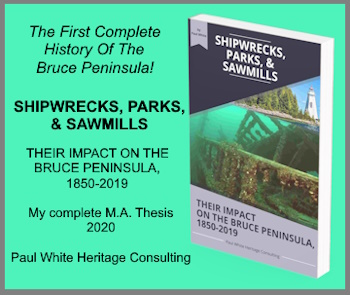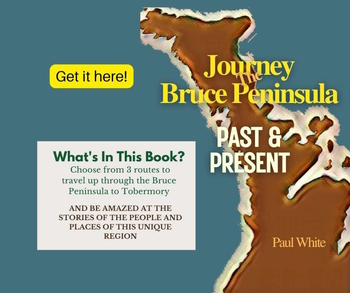The Leith Golf Course
The Leith Golf Course has provided many families with great memories. The history of this golf course starts, and ends, with the generosity of one family.
When I was a youngster the arrival of spring signalled the beginning of a new sports season. The warm sun melted the ice rinks in our back yards and raised the temperatures to heights that allowed us to shed our scarves and toques. We put our hockey equipment into storage in the basement and brought out our baseball bats, balls and gloves. But the spring of 1962 marked the beginning of a new sports ritual in our home, cleaning golf clubs.
In the 1960s our family joined the Leith Golf Course. For the next decade pilgrimages along the shore road to Leith were almost a daily occurrence in our family. If my father couldn’t drive me to the course, I slung my golf bag over my shoulder and rode my bicycle to Leith and after the long ride I would often play as many as 36 holes of golf before I pedaled home.
The Founding of the Leith Golf Course
The Leith Golf Course had a rich and unique history. On March 30, 1923 a group of area sportsmen gathered for a meeting at the offices of T.I. Thomson. The object of this gathering was to formulate the establishment of a golf course. The result of this meeting was the creation of the Leith Golf Club. T.I. Thomson was named president and C.A. Fleming held the position of vice-president. Others selected to club’s first executive were J.R. Dier, Rixon Broderick, W.P. Telford, Fred Harris, Percy Lee, Howard Fleming and Charles Lee.
The course was built on land owned by two sisters, Eleanor and Laura Rixon. The Rixon’s were avid golfers and they leased their property to the club for the minimal amount of $20 per year and the members were responsible for the maintenance of fences and the grounds.
The Leith Golf course never aspired to be a corporate entity. Instead it was a communal project. Members helped cut the greens, put the bridges up in the spring and take them down in the autumn. The Rixon ladies wanted the course to be accessible to families and required the club to keep its memberships affordable. When my family first joined a single membership for the season was $10.00 and a family could play for $15.00.
The Leith Golf course did not have long and wide-open fairways. Instead, it was a tight, short course nestled among trees with a river meandering beside and across many of the holes. It was the perfect course to develop a golfer’s “short iron” game. The third hole was an example of the accuracy required to play the course. The tee-off was located on the river’s edge. The player was required to hit a ball across the river, past a high sand bank to a narrow fairway. If you hit the ball too hard, you would end up in the bush. There was a “dog-leg” to the left, and down a hill to a green which was hidden behind a giant tree. The river flowed to the left of the green and the woods were on the right. This hole was definitely not designed for a big hitter with little accuracy!
The course was hidden from view with a thick forest separating it from the road. There was no grand sign in front of the club announcing to passers-by its very existence. Instead, a small sign on a post at the gate to the entrance told golfers to pick up their score cards and pay their fees at the general store across the road.
True to the wishes of the Rixon family the Leith Golf Course had a strong family atmosphere. Everyone pitched in to make the course a viable entity. Most Saturday evenings a two-ball foursome tournament was played, and although competition was keen the point of the evening was a good time.
In 1973 Eleanor Rixon passed away. Her sister, Laura, had predeceased her by almost two decades. Her passing marked the end of the golf course.
Although the Leith Golf Course has faded from the landscape of sports and recreation in the Grey and Bruce area. Its memory lives on, with those of us who were lucky enough to have been members but also with golfers who visited the area and tested their skills on the tight fairways and tricky greens.
More Grey County Pages
12-year-old Walks to Owen Sound in 1851 from the journal of a teenage boy's experience travelling with his brother in the untamed Upper Canadian wilderness.
1st Grey County Building in 1852 was only built after many hurdles were overcame.
Dr. Anna Henry from Markdale, was a medical trailblazer for women doctors in Canada, who helped lay the groundwork for the establishment for Women's College Hospital.
Egremont Township endured the usual growing pains of a pioneer community, but its early history records times when it was embroiled in a few contentious issues.
Euphrasia Township in the early years when spelling the name was a problem for those who called it home and those that wanted settle this new Grey County township.
Georgian Bay's 1st pioneer settler arrived on the western shoreline long before any other settler reached the area.
Grey County Heritage: A Valuable Resource which is rich and varied, as an important resource for future use for business, political, and many other purposes.
Grey County's Creation in 1852, laid the framework for organizing a county in the last wilderness in the southern region of what would become in the future the province of Ontario.
An Unlikely Hero From Grey County (Part 1) found his way from the farming community of Flesherton to missionary work in the Ottawa Valley, and beyond.
An Unlikely Hero Vs. The KKK (Part 2) Our hero from Grey County took his missionary zeal south of the border and ultimately crossed paths with the infamous KKK!
Barn Raising: A Pioneer Economic and Social Necessity as it provided settlers with an opportunity not only to build a barn, but also build a community.
"Barring Out": A Pioneer School Tradition was a custom which the settlers brought to the new world from England, or Scotland.
Ceylon Ontario: How it Got its Name: It is always interesting how a community got its name, but I doubt any place received its name from a more unique source!
Chatsworth Ontario: First Settlers took advantage of fulfilling the needs of pioneer travellers and built a thriving community in the Upper Canadian wilderness.
Clearing Trees a Daunting Task for Settlers as they worked to fulfill their obligations for their land grant.
Dornoch: or is it Smithville? Originally it was Smithville, then it became Dornoch. But, surprise it is still, in reality Smithville!
First Pioneer in Durham: Archibald Hunter established his family, and a hotel, in what would become the centre of the town of Durham.
Durham Ontario Influenced by the Saugeen River. This river provided a means to create new industries, but especially in the spring it can also pose a menace to the community.
Grey County Bylaws to the 1890s reveal a lot about the financing of local government, especially education in the early days of the region.
John Muir, the legendary naturalist, who promoted the idea of protected nature spaces, spent time in Ontario and I went to help find evidence of his stay in the Owen Sound area.
A Heroic Woman From Grey County who made great changes as a doctor in China in the 1890s and early 1900s.
Jesse James: In Grey County? An interesting question. Did the notorious gangster hide out in Proton Township? We will never know. But it is fun to speculate!
Kilsyth's Train Engine was one for the history books. It brought an evening of joy followed by disappointing news soon after.
The Knight's of Meaford have long history in that Grey County community. Their business forged by early settlers employed many locals and supported the economy.
Leith: Tom Thomson's Birthplace is part of the rich heritage of this community located on the east shore of the Georgian Bay north of Owen Sound.
The Leith Golf Course has provided many families with great memories. The history of this golf course starts, and ends, with the generosity of one family.
Agnes Macphail was a political trailblazer in a part of Ontario that one could hardly expect such radical action for the era in a rural region.
Markdale Ontario: The Beginning: originally known as Glenelg East, but the coming of the railway and the name of owner of the land for the station led to a change of identity.
Meaford's history is one of hardy and entrepreneurial pioneers carving their lives out of the wilderness of what would become Grey County.
Meaford Ontario, first called Peggy's Landing located on the shores of Georgian Bay has a rich history.
Meaford vs Purdytown. Conflict over the name of a new community was not unusual in early Grey County but electing a school trustee was the "hot button" issue in this rivalry.
Pioneer Clergyman: John Neelands was the first to minister to the first settlers' spiritual needs riding on horseback through the wilds of early Grey County.
Pioneer Doctor: Dr. James Smith, a local boy who became a doctor and served his community for his entire life was a testament to Grey County community spirit.
Pioneer Healthcare in Grey and Bruce counties was not administered by doctors, nurses, or pharmacists, no it was the responsibility of the women of the community.
Pioneer Homes in Grey County in the 1840s offered only basic amenities. Homes were basic because clearing the land to earn a living to survive were of paramount importance for those embarking on a new life.
Pioneer Ingenuity created many labour saving devices and methods and quite often helped to create a sense of community.
Pioneer Christmas: A Family Tradition as told to me by may grandparents who experienced Christmas as children in the 1880s and 1890s.
Pioneer Settlement Plans for Grey County began almost two decades before the rest of Grey County was available for settlement.
A pioneer road surveyor's impact on the local history of Grey and Bruce counties could have been dramatic, if it had not been changed by another surveyor.
Pioneer Teachers in Grey and Bruce Counties had a long and arduous task, not to mentions strict and confining job requirements for very little salary.
Plowing Match in Grey County in 1933 the first International Plowing Match held in Grey and Bruce counties and it's success led to more such events in Grey.
Settling Osprey Township: Parts of Osprey were considered too rugged to settle, but today they are prime real estate because of the great view!
Swamp College: Proton Township: this colourfully named institution of education in Grey County has provided many stories to the heritage of the region.
Sydenham Township's First Council undertook the often difficult task of creating a new municipal infrastructure.
The Impact of Snow is not what is Used to be! As snow removal equipment has improved the impact of snow on our lives has reduced significantly from previous eras.
Unique Characters: Nathaniel Herriman lived in Grey County and owned an inn to provide food and and accommodation to early travellers. Each day he performed a unique practice.
Unique Maps: Quilts Guided the Underground Railroad to enable runaway slaves to escape to Canada and freedom from the shackles that enslaved them.
The Women's Institute is a group of rural women that has made a difference to the quality of both urban and rural life in Grey County and across the country.





